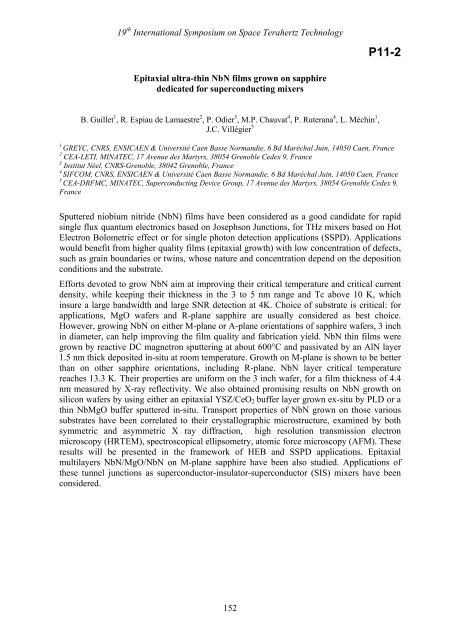Program and Abstract Book - SRON
Program and Abstract Book - SRON
Program and Abstract Book - SRON
Create successful ePaper yourself
Turn your PDF publications into a flip-book with our unique Google optimized e-Paper software.
19 th International Symposium on Space Terahertz Technology<br />
P11-2<br />
Epitaxial ultra-thin NbN films grown on sapphire<br />
dedicated for superconducting mixers<br />
B. Guillet 1 , R. Espiau de Lamaestre 2 , P. Odier 3 , M.P. Chauvat 4 , P. Ruterana 4 , L. Méchin 1 ,<br />
J.C. Villégier 5<br />
1<br />
GREYC, CNRS, ENSICAEN & Université Caen Basse Norm<strong>and</strong>ie, 6 Bd Maréchal Juin, 14050 Caen, France<br />
2 CEA-LETI, MINATEC, 17 Avenue des Martyrs, 38054 Grenoble Cedex 9, France<br />
3 Institut Néel, CNRS-Grenoble, 38042 Grenoble, France<br />
4<br />
SIFCOM, CNRS, ENSICAEN & Université Caen Basse Norm<strong>and</strong>ie, 6 Bd Maréchal Juin, 14050 Caen, France<br />
5<br />
CEA-DRFMC, MINATEC, Superconducting Device Group, 17 Avenue des Martyrs, 38054 Grenoble Cedex 9,<br />
France<br />
Sputtered niobium nitride (NbN) films have been considered as a good c<strong>and</strong>idate for rapid<br />
single flux quantum electronics based on Josephson Junctions, for THz mixers based on Hot<br />
Electron Bolometric effect or for single photon detection applications (SSPD). Applications<br />
would benefit from higher quality films (epitaxial growth) with low concentration of defects,<br />
such as grain boundaries or twins, whose nature <strong>and</strong> concentration depend on the deposition<br />
conditions <strong>and</strong> the substrate.<br />
Efforts devoted to grow NbN aim at improving their critical temperature <strong>and</strong> critical current<br />
density, while keeping their thickness in the 3 to 5 nm range <strong>and</strong> Tc above 10 K, which<br />
insure a large b<strong>and</strong>width <strong>and</strong> large SNR detection at 4K. Choice of substrate is critical: for<br />
applications, MgO wafers <strong>and</strong> R-plane sapphire are usually considered as best choice.<br />
However, growing NbN on either M-plane or A-plane orientations of sapphire wafers, 3 inch<br />
in diameter, can help improving the film quality <strong>and</strong> fabrication yield. NbN thin films were<br />
grown by reactive DC magnetron sputtering at about 600°C <strong>and</strong> passivated by an AlN layer<br />
1.5 nm thick deposited in-situ at room temperature. Growth on M-plane is shown to be better<br />
than on other sapphire orientations, including R-plane. NbN layer critical temperature<br />
reaches 13.3 K. Their properties are uniform on the 3 inch wafer, for a film thickness of 4.4<br />
nm measured by X-ray reflectivity. We also obtained promising results on NbN growth on<br />
silicon wafers by using either an epitaxial YSZ/CeO 2 buffer layer grown ex-situ by PLD or a<br />
thin NbMgO buffer sputtered in-situ. Transport properties of NbN grown on those various<br />
substrates have been correlated to their crystallographic microstructure, examined by both<br />
symmetric <strong>and</strong> asymmetric X ray diffraction, high resolution transmission electron<br />
microscopy (HRTEM), spectroscopical ellipsometry, atomic force microscopy (AFM). These<br />
results will be presented in the framework of HEB <strong>and</strong> SSPD applications. Epitaxial<br />
multilayers NbN/MgO/NbN on M-plane sapphire have been also studied. Applications of<br />
these tunnel junctions as superconductor-insulator-superconductor (SIS) mixers have been<br />
considered.<br />
152
















